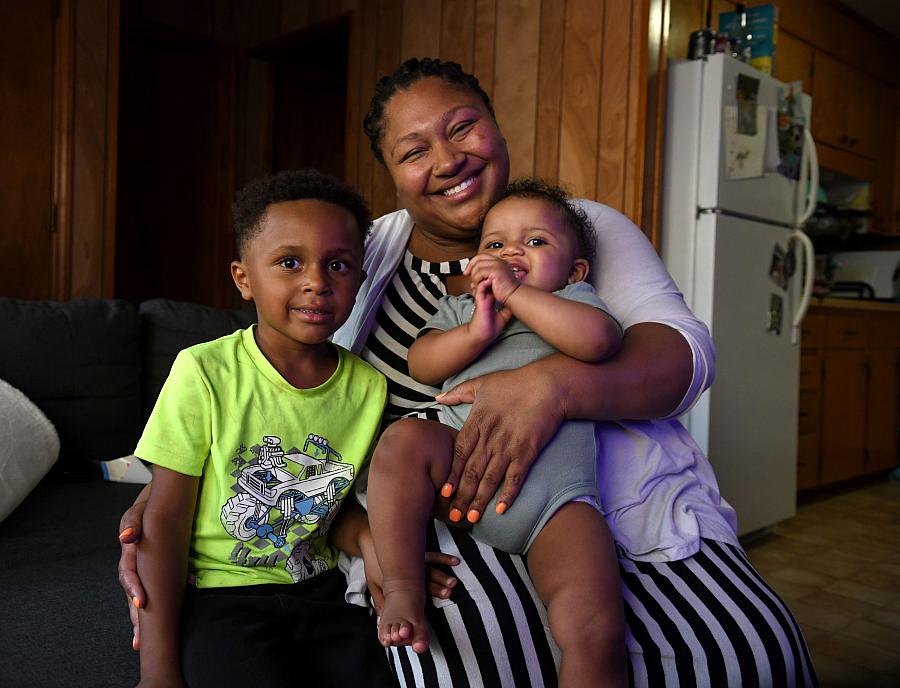A reporter brackets solutions and lets powerful stories stand for themselves in Virginia’s maternity care deserts

Alexis Ratliff, 29, with her son Ezekiel, 5, and 11-month-old daughter Eleah Witcher in their Rocky Mount home. The mother, featured in the author’s recent reporting on maternity care gaps in rural Virginia, had a doula to help with the birth of Eleah.
(Courtesy photo by Natalee Waters/Cardinal News)
As I navigated the narrow, winding roads of Southwest Virginia, a torrential downpour hammered against the roof of my car. The rainwater pooled on the asphalt, obscuring the road lines while my windshield wipers struggled to keep pace.
Twice I pulled to the side of the road just to give my nerves a break, but it was clear the storm wasn’t blowing over, and I had an interview to get to in Grundy, Virginia.
I thought about the women in these far-flung communities and how much worse this drive would be for someone in labor. My reporting was focused on the closure of rural labor and delivery rooms in the Southwest and Southside regions of the state and the ever-increasing distances between essential maternity care.
I heard stories from Virginia providers about women giving birth in emergency departments when they couldn’t make it to a hospital with a delivery unit in time. Other women were opting for labor induction to avoid this scenario, while others were desperately calling hospitals in nearby states as staffing shortages temporarily paused services at their hospital of choice.
In 2024, just under 15% of Virginia women had no birthing hospital within 30 minutes, compared to about 10% in the United States, according to the March of Dimes.
Over the past seven years, five labor and delivery rooms closed across Virginia, leaving only eight of the state’s 28 hospitals with obstetric services. Two of those closures occurred in the last three years.
Even the hospitals still operating delivery units face intermittent service disruptions due to staffing shortages and restrictive state laws preventing credentialed providers from performing certain newborn assessments.
Solutions-based reporting worked at first
Initially, I framed my reporting around the assumption that distance was the primary barrier to maternity care in the state. I wanted to explore new models of care that could bridge these gaps, leaning heavily into solutions-based journalism.
That approach worked well for my first story, where I explored the increasing use of doula services, particularly among Black women.
Alexis Ratliff, a single mom of two, not only had to budget for diapers and formula but also for six weeks of unpaid maternity leave from her job at the Martinsville courthouse.
Virginia has yet to pass legislation requiring employers to provide paid parental leave, a measure that would improve infant and maternal health outcomes, according to the March of Dimes.
The drive from Martinsville, which lost its labor and delivery unit in 2022, meant she took at least half a day off work for each prenatal visit. By the time her baby girl arrived, she had exhausted all her paid leave.
She took advantage of Virginia Medicaid’s newly expanded coverage for doula care. Ratliff’s doula met with her during lunch breaks, so she could avoid taking any more time off work.
“I was like, Here’s someone that is down to earth. Here’s someone that is actually talking to me and explaining a lot of things. Because when you’re with your doctor, I mean, I think it was like five or seven minutes with each patient,” Ratliff said.
Embrace flexibility, it will result in more nuanced stories
Other conversations I had with obstetric leaders complicated my plan to focus exclusively on potential solutions. They spoke not just of women forced to drive hours for prenatal care, but of women avoiding care entirely due to stigmas around substance use disorder.
I quickly realized my reporting had to expand. Addressing the needs of pregnant women in active addiction meant loosening my rigid focus on solutions-based journalism. I had equated impact with offering answers, but the stories I encountered demanded another approach.
I met Miracle Hawkinberry at the Buchanan County Courthouse in Grundy. I was surprised at her choice of meeting place. From our earlier conversations, I knew that she had struggled with opioid addiction and faced some of her hardest moments in that courthouse. But it was also the place where she learned she had a chance to keep custody of her youngest child, Honey.
Hawkinberry spent more than a decade trying to achieve long-term recovery. She tried to stop using when she was pregnant with her other children, but in the isolated clinics in the far reaches of Southwest Virginia, she didn’t know where to get help. Her obstetricians never presented any options for her, but then again, she never trusted them enough to be completely honest about her situation.
Her recovery started in drug court, about five months into her final pregnancy. It wasn’t the narrative I had expected as I looked for glimmers of hope in the health care system.
A conversation with my senior fellow and local editors helped clarify my path. Impact journalism doesn’t always mean providing a checklist of solutions. Sometimes, it’s simply saying, “This is happening in our community,” and letting the stories stand for themselves.
With this fellowship, I was able to come back with another story to outline services that could make a difference in rural Virginia, but didn’t exist there yet. Those stories were even more meaningful because they followed a powerful story from someone who could have benefited from these services.
I found that adhering rigidly to my preconceived notions could have hindered the discovery of other authentic stories. I embarked on this project with a specific angle in mind, but the essence of impactful journalism lies in the willingness to adapt.

